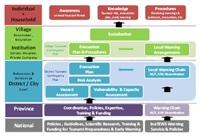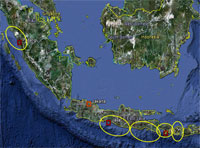Project Info PROTECS
InaTEWS was designed and set up through the joint efforts of a number of Indonesian institutions supported by projects from international partners during the period 2005 to 2010. This initial phase involved a learning and development process, which was mainly project-driven. While the upstream part and the implementation of the NTWC required specialised input from science and technology, the learning and innovation process in the downstream part and at the community level was facilitated by pilot projects (like the GITEWS working package "Capacity Development in Local Communities") in different areas of the archipelago. Since 2011, the character of the activities by the main actors involved in InaTEWS has shifted from time-limited project work to continuous service provision. Core services related to InaTEWS are the provision of tsunami early warnings by the National warning Center to interface institutions, the dissemination of warnings by the national mass media to the general public and the provision of guidance - especially calls for evacuation – by local governments to communities at risk. Other related services include the provision of reference tools for community preparedness, such as tsunami-hazard maps and evacuation plans provided by the BPBDs, as well as information campaigns to raise knowledge and awareness at the grassroots level. The experiences from the pilot phase showed that the capacities of the main stakeholder to provide such services were not developed yet sufficiently.
The GITEWS review process in 2010 concluded that integrating the requirements of the warning system (e.g. procedures) within local institutions was a precondition to achieving sustainability. The reviewers also concluded that InaTEWS could not be considered "complete", as the majority of tsunami-prone districts and communities in Indonesia had yet to be linked to the system. Thus, the need for a strategy that would link these districts and communities to InaTEWS and would strengthen local response capabilities to enable communities to react adequately to warnings was also pointed out.
Based on these considerations it was agreed that PROTECTS should support national government institutions, local governments and civil society actors to strengthen their capacities to provide the services necessary for sustainable tsunami preparedness.
Our Partners
The State Ministry for Research and Technology (RISTEK) is the political partner. At national level the project cooperates with the National Disaster Management Agency (BNPB), the Indonesian Institute of Sciences (LIPI) and the National Agency for Meteorology, Climatology and Geophysics (BMKG). Partners on province and district levels are the recently established disaster management agencies (BPBD).
Approach
The PROTECTS project makes use of the products of “GITEWS - Capacity Development in Local Communities” and the experiences in the GITEWS Pilot Areas as an input for the development of national references and the integration of tsunami early warning and preparedness into the overall Indonesian disaster management. Strengthening local disaster management agencies in community oriented tsunami risk management is regarded necessary to make tsunami early warning effective. The project furthermore will contribute to promote a common understanding of InaTEWS and the warning services on the part of the related institutions and the general public. The project will contribute to share the experiences from Indonesia with international and regional platforms like the ICG IOTWS and UNISDR.
 Based on the experiences from GITEWS pilot areas, the Structured Approach towards tsunami preparedness across multiple levels was refined and used as a guiding principle especially for working processes on the local level.
Based on the experiences from GITEWS pilot areas, the Structured Approach towards tsunami preparedness across multiple levels was refined and used as a guiding principle especially for working processes on the local level.
The PROTECTS project also continued the multi-level approach of GITEWS, as coordination and communication between province, district/city and national level is considered a pre-requisite for an effective InaTEWS and locally adapted, sustainable capacity development for tsunami risk management.
During 2012 the project joined a Private-Public Partnership initiative with PT Asuransi MAIPARK Indonesia and the GIZ DeCGG (Decentralisation as Contribution to Good Governance) program to enhance capacities in terms of disaster mitigation and preparedness through public awareness improvement in the south coastal area of Gunung Kidul district, Yogyakarta province.
Project Areas
 Project areas during the PROTECTS project were located in DIY (Gunung Kidul, Kulon Progo), East-Java (all eight tsunami prone districts), Bali (Badung, Gianyar, Tabanan, Buleleng) and Lombok (Kota Mataram, Districts of North and East Lombok). Cooperation in West-Sumatra focused on supporting the further development of the warning chain at province level and on contingency planning. Advisory processes on national level and the development of the training modules were coordinated from team members based in the project offices at BMKG and BNBP in Jakarta.
Project areas during the PROTECTS project were located in DIY (Gunung Kidul, Kulon Progo), East-Java (all eight tsunami prone districts), Bali (Badung, Gianyar, Tabanan, Buleleng) and Lombok (Kota Mataram, Districts of North and East Lombok). Cooperation in West-Sumatra focused on supporting the further development of the warning chain at province level and on contingency planning. Advisory processes on national level and the development of the training modules were coordinated from team members based in the project offices at BMKG and BNBP in Jakarta.
Expected results
National standards, guidelines and manuals concerning tsunami early warning and tsunami risk management are developed to provide official references to local stakeholders across all tsunami prone areas of Indonesia.
Districts threatened by tsunamis in Java, West-Sumatra, Bali and NTB are strengthened in tsunami risk management by providing access to relevant information and knowledge through networks, trainings and consultancies facilitated by provincial disaster management agencies. In this regard, the project also supports the horizontal exchange of experiences between the former GITEWS pilot areas and other districts and provinces involving national institutions.
The project supports initiatives to promote a better understanding about InaTEWS and the warning services by all actors involved and contribute to the further development of InaTEWS warning products in accordance with the needs of the end-users.






